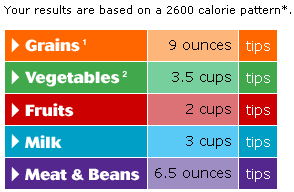Building Your Own Food Pyramid
The U.S. government is making it possible for everyone with Internet access to build their very own food pyramid.
Building the Pyramid (WaPo, p. HE01)
Limber up your fingers, swab your computer screen and grab a cup of your favorite low-cal beverage. The federal government’s new food guide system hands you the blueprints to construct your own detailed food pyramid, but be prepared to spend some time building it — if you have access to a computer and the Internet, that is. The new icon is based on the 2005 Dietary Guidelines jointly issued in January by the Department of Health and Human Services and the Department of Agriculture (USDA) to wide acclaim. For the first time, the agencies have made it possible to customize the pyramid to your age, gender and activity level and to decide whether to maintain your current weight or reach a healthier one.
In giving the pyramid a facelift, the USDA and its partner, the international marketing firm Porter Novelli, essentially turned the old version on its side. Gone are the horizontal lines designating food categories. Instead, the new pyramid represents the same categories using colorful stripes that run from tip to base. It also has a staircase marching up one side, a reminder for the chronically sedentary American public to be more active. Unlike the old pyramid, the new version can be both interactive and customized. It puts into practice the 2005 Dietary Guidelines, widely considered the among the best issued. But for now the new pyramid is almost entirely a creature of the Web — a fact that has drawn criticism from some nutrition experts as well as consumer and industry groups. Critics say that tax dollars are ill spent if those who need the pyramid’s information require a computer and Internet access to get it.
“People need very clear advice without having to log onto the Web,” said Margo G. Wootan, nutrition policy director of the consumer advocacy group Center for Science in the Public Interest. The government “is pinning their hopes to combat obesity on a Web site that is sure to lead to disappointment.”
In the first 72 hours, the pyramid Web sites logged 160 million hits — 20 percent of them from outside the country, according to the USDA. This overloaded the sites’ computers, making them inaccessible. The USDA quickly added computing power, which seemed to resolve the problem.
While the idea is at first rather comical–the whole idea of the “food pyramid” is to simplify the idea of a “healthy diet”–it actually makes a lot of sense. Of course, a lot of people will claim to be more muscular and more active than they really are in order to get a more favorable dietary recommendation.
The site is at MyPyramid.gov. If I put in my age and my actual amount of average daily physical activity, I get the following:

If I exaggerate my activity level slightly, I get a couple hundred more calories:

I’d rather have the bottom diet although, frankly, there’s not a lot of customization happening here. A somewhat more detailed analysis, available after answering quite a few more questions, is available at www.mypyramidtracker.gov. It requires site registration and entry of all the foods you’ve eaten in the last 24 hours. Given that there’s no way I’m eating all the vegetables it’s going to tell me I should, I declined to go further.





As a graphic artist, I applaud the USDA for coming up with a winning, thought provoking design. The fact that there is more than one pyramid has been criticized unfairly in my opinion. One size does not fit all.
The main message of the pyramid is and always has been to get REGULAR exercise and to eat a WELL BALANCED diet. No matter what the artwork looks like or no matter whether you have access to the internet or not, this message will unfortunately be lost on most of American’s. Our society has been brought up on a diet of fattening fast food for “convenience” sake, have forgotten how to eat and shop for good whole foods, and are more inactive than ever before.
I applaud the USDA for coming up with this new conceptual way to illustrate what healthy eating is and that exercise MUST be part of the picture.
How many homeless people could have been fed with all the tax dollars spent on developing a chart that will not make a differnece in more than 1% of peolpe in America, what a joke. Another perfect example of our tax dollars hard at work.